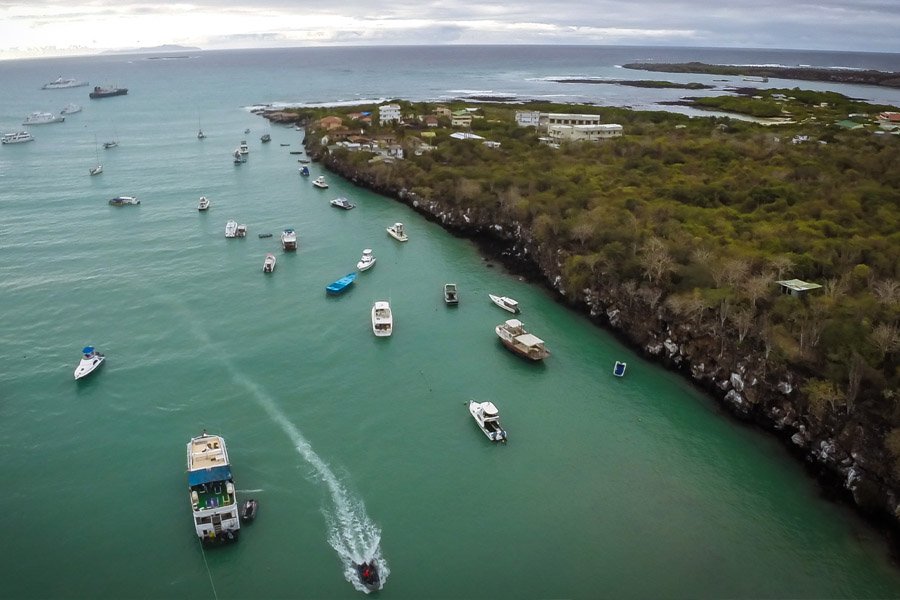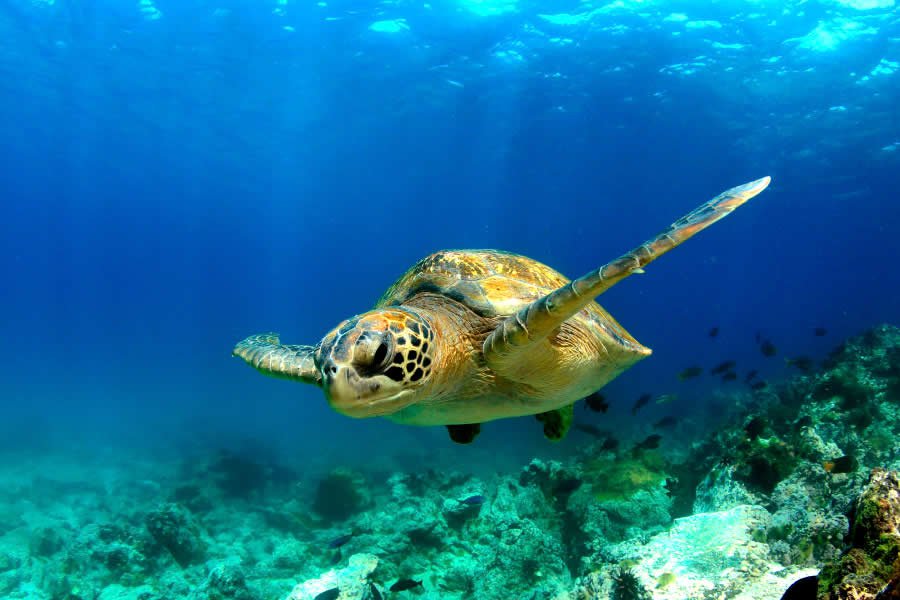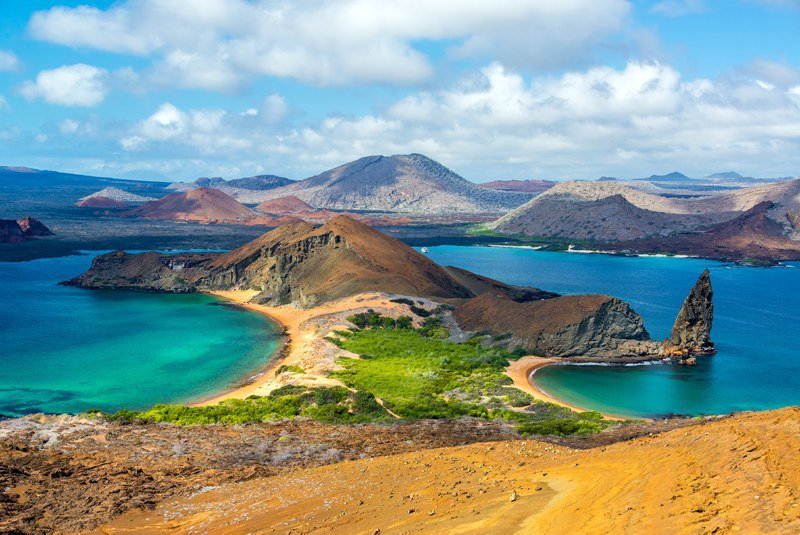Paradise 8Days|7Nights
Tour Package 8 Days / 7 Days
Santa Cruz Island is one of Galapagos Island with an area of 986 km2 (381 sq mi) and a maximum altitude of 864 metres (2,835 ft). Situated in the center of the archipelago, Santa Cruz is the second largest island after Isabela. Its capital is Puerto Ayora, the most populated urban centre in the islands. On Santa Cruz there are some small villages, whose inhabitants work in agriculture and cattle raising. This island is a large dormant volcano. It is estimated that the last eruptions occurred around a million and a half years ago. There is a gigantic lava tunnel that is over 2000 meters long on the island that many tourists visit and walk through. As a testimony to its volcanic history there are two big holes formed by the collapse of a magma chamber: Los Gemelos, or "The Twins".Named after the Holy Cross, its English name (Indefatigable) was given after a British vessel HMS Indefatigable Santa Cruz hosts the largest human population in the archipelago at the town of Puerto Ayora, with a total of 12,000 residents on the island.
Tour Itinerary.
First day:
AM: Pick up from the airport and drop off at the hotel
Afternoon: Lunch and Visit the Charles Darwin Research Station, An incredible place where you can learn about the history of the Galapagos Ilsands as well as thier flora and fauna. Also the famous as the home of legendary Lonsome George (Chelonoidis nigra abingdonii), (the last tortise remaining of his species). Lonsome George was origianally from Pinta island. In 1971 he was brought to the research station in Santa Cruz. He died on June 24th 2012.
Second Day:
Am: Santa Cruz Island bay tour, includes snorkeling in La Loberia and hiking around the island. We will visit the Shark Channel (Tintoreras) and the Lovers Channel (Canal Del Amor) then we will walk to the cristal clear waters of Las Grietas.
PM: Visit the Highlands of Santa Cruz and see the Galapagos turtles in their natural hábitat. Then we will go visit and hike through the lava tunels.
Third Day:
From: 8:00 Am. To:5:00 Pm.
North Seymour & Bachas beach Or Floreana Island.
North Seymour ( Isla Seymour Norte) is a small island near to baltra island in the Galapagos Island. It was formed by uplift of a submarine lava formation. The whole island is covered with low, bushy vegetation.
The island is named after an English nobleman, Lord Hugh Seymour. North Seymour Island has an area of 1.9 square kilometres (0.73 sq mi) and a maximum altitude of 28 metres (92 ft). This island is home to a large population of blue-footed boobies and swallow-tailed gulls. It hosts one of the largest populations of magnificent frigatebirds (Fregata magnificens ) and a slow growing population of the Galapagos land iguanas (Conolophus subcristatus ).
North Seymour was created by seismic uplift, rather than being of volcanic origin. The island has a flat profile with cliffs only a few meters from the shoreline, where swallowtail gulls and tropicbirds sit perched in ledges. A tiny forest of silver-grey Palo Santo trees stand just above the landing, usually without leaves, waiting for rain to bring them into bloom.
The highlights: Sea lions,Land iguanas, Swallow-tailed gulls, Lava gulls, Migratory shore birds,Marine iguanas, Great & Magnificent frigate birds, Blue footed boobies, Brown noddie terns, Brown pelicans, Flamingos, White tip sharks, Sting rays, Sea turtles and various migratory shore birds.
Wath to bring & To use:
Small backpack (waterproof), Comfortable walking shoes, Sneakers or rubber soles, Shorts Trousers, T-shirts, Long and Short sleeved shirts Windbreaker, Bathing suit, Wet suit (for snorkeling between June - November), Hat or cap, Toilette kit, Sun block, Sunglasses, Binoculars, Camera & camcorder.
Includes: English speaking guide,Transportation,Snorkel equipment, Lunch on board, Towels, Excursions, drinking water.
Fourth Day & Fifth Day
San Cristóbal (Chatham) is the easternmost island in the Galapagos archipelago as well as one of the oldest geologically.
San Cristóbal has an area of 558 km2 (215 sq mi) and its highest point rises to 730 metres (2,400 ft). The population is approximately 6000. San Cristóbal is the most fertile island of the archipelago and is the second most populated after Santa Cruz. The capital of the archipelago, Puerto Baquerizo Moreno, lies at the south-western tip of the island.
Its Spanish (and official Ecuadorian) name "San Cristóbal" comes from the patron saint of seafarers, St. Christopher. English speakers increasingly use that name in preference to the traditional English name of Chatham Island, derived from William Pitt, 1st Earl of Chatham.
San Cristobal Island is composed of 3 or 4 fused volcanoes, all extinct. It is home to the oldest permanent settlement of the islands and is the island where Darwin first went ashore in 1835. A small lake called El Junco is the only source of fresh water in the islands. The availability of fresh water is what led to the early settlement of San Cristobal. A penal colony was built on San Cristóbal Island in 1880 for prisoners from mainland Ecuador. This later turned into a military base for Ecuador and export center for the island's products including sugar, coffee, cassava, cattle, fish and lime.
The majority of inhabitants make their living in government, tourism, and artisanal fishing. Also the majority of the residents of San Cristóbal live in the port city of Puerto Baquerizo Moreno, which is the capital of the Galápagos province. Island tourism sites nearer the town of Puerto Baquerizo Moreno include the Cerro Tijeretas, a nesting colony for Frigate birds and a statue of Charles Darwin, marking the original site where he first disembarked in the Galápagos Islands during the voyage of the Beagle, on 16 September 1835. La Loberia, a colony of sea lions, lies about ten minutes by bus from the town.
The Highlights.
This island hosts frigatebirds, Galapagos sea lions, Galapagos tortoises, blue and red footed boobies, tropical birds, marine iguanas, dolphins and swallow-tailed gulls. Its vegetation includes Calandrina galapagosa, Lecocarpus darwinii, trees such as Lignum vitae,Matazarna. In the waters nearby are sharks, rays, and lobsters.
The largest fresh water lake in the archepelago, Laguna El Junco, is located in a crater in the highlands of San Cristóbal, in the southern half of the island. The lake harbors a large population of birdlife, but reaching the lake requires a short uphill walk. Nearby, La Galapaguera is a breeding station and sanctuary for giant tortoises.
"Kicker Rock" (the Spanish name is "León Dormido") represents the remains of a lava cone, now split in two, DIVE SPOT. "Isla Lobos" (sea lion island) is also a nesting site for blue-footed boobies.
Wath to bring & To use:
Small backpack (waterproof), Comfortable walking shoes, Sneakers or rubber soles, Shorts Trousers, T-shirts, Long and Short sleeved shirts Windbreaker, Bathing suit, Wet suit (for snorkeling between June - November), Hat or cap, Toilette kit, Sun block, Sunglasses, Binoculars, Camera & camcorder
Includes: Transportation, English speaking guide,Lunch,norkel equipment, Excursions, drinking water.
Sixth Day & Seventh Day:
Isabela Island (Is the largest island of the Galapagos with an area of 4,640 square kilometres (1,790 sq mi) and length of 100 kilometres (62 mi) almost four times larger than Santa Cruz, the second largest of the archipelago. It was named after Queen Isabela of Spain. It was originally named Albemarle after the Duke of Albemarle. The island strides the equator.
One of the youngest islands, Isabela is located on the western edge of the archipelago near the Galapagos hotspot . At approximately 1 million years old, the island was formed by the merger of 6 shield volcanoes-Alcedo,Cerro Azul, Darwin, Ecuador,Sierra Negra and Wolf. All of these volcanoes except Ecuador are still active, making it one of the most volcanically active places on earth. Two of the volcanoes, Volcan Ecuador and Volcan Wolf (the island's highest point with an elevation of 1,707 m (5,600 ft), lie directly on the equator. The island is primarily noted for its geology, providing excellent examples of a geologic occurrence that created the Galapagos Island including uplifts at Urvina Bay and the Bolivar Channel, tuff cones at Tagus Cove, and Pulmace on Alcedo and Sierra Negra, one of the most active volcanoes in the world.
What you will do: visit the lagoon of the Flamingos, the tortise breeding center ¨La Galapaguera¨, have lunch, go to the Tintoreras, snorkel.
you can see: Galapagos Pinguins,White Tip Sharks, Flamingos, Green Sea Turtles, Blue Footed Boobies, Sea Lions, Marine Iguanas ans many variety of Fish.
Wath to bring & To use:
Small backpack (waterproof), Comfortable walking shoes, Sneakers or rubber soles, Shorts Trousers, T-shirts, Long and Short sleeved shirts Windbreaker, Bathing suit, Wet suit (for snorkeling between June - November), Hat or cap, Toilette kit, Sun block, Sunglasses, Binoculars, Camera & camcorder.
Includes: Transportation, Lunch, Snorkeling equipment, and Bilinguil Guide.
Not Included: Entrance Fee at the main pier ($5)
Eighth Day: Optional visit to Los Gemelos (the twins) before being dropped off at the Airport.
Eighth Day: Optional visit to Los Gemelos (the twins) before being dropped off at the Airport.
Prices include taxes.
Package INCLUDES
- hotel
- breakfast
- lunch
- snorkel equipment
- transportation
- naturalist guide.
Package DO NOT include
- Galapagos Airfare Ticket
- Galapagos Park Fee $100
- Ingala Migration Card $ 20
- Isabela Dock Fee $ 5
- Dinners (prices from $ 7 - $15)
- alcoholic beverages
- Tips.
For more info, CONTACT US.

Galapagos Islands Cruises
Galapagos Islands Tours
Galapagos Islands Diving
Galapagos Last minutes
Trips to Galapagos Islands
Galapagos Tours
Galapagos Cruises
Cruises to Galapagos
Tours to Galapagos
Travel to Galapagos
Travel to Ecuador
Travel to Peru
Travel to South América
Travel to Amazonas
Tourism Tour Galapagos Islands
Visiting Giant Turtles Giant Tortoises in Galapagos










